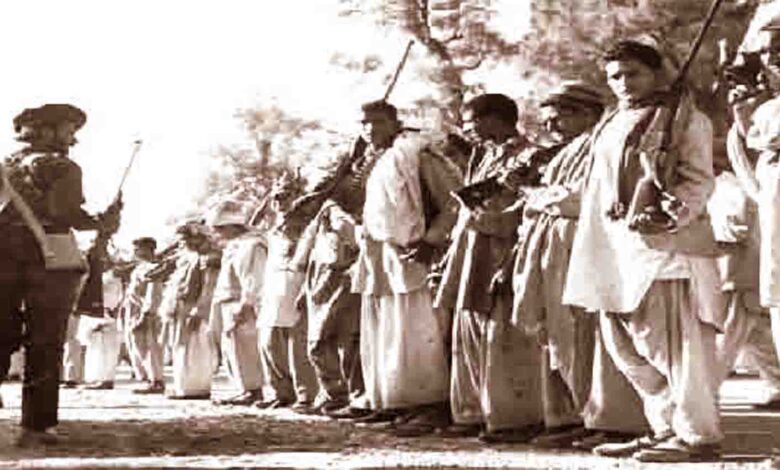VIEWPOINT : Tryst with Jihad in Kashmir: The sinister start

 Romit Bagchi
Romit Bagchi
An uncertainty was hanging heavy in the autumn air of Jammu and Kashmir after the British rule ended. With the end of the rule, the British paramountcy over the Princely States ended. In step with the two-nation theory, the Hindu-majority Princely States were merging with India while those with the Muslim majority were acceding to Pakistan. But the Dogra Rajput ruler of Jammu and Kashmir, Maharaja Hari Singh was in a dilemma. He favoured his State remaining independent, avoiding becoming part of either of the sovereign dominions-India or Pakistan- given their bellicose relation. On August 12, 1947, he had sought a standstill agreement with both India and Pakistan. India had responded and asked Hari Singh to start discussions with Delhi. But the king was unresponsive. Pakistan had also accepted his offer and decided to wait.
The king needed time to weigh his options. He feared a fierce Muslim uprising if he acceded to India and if he joined Pakistan the Hindus and Sikhs would become dangerously vulnerable. As days passed with the Maharaja maintaining a stony silence, Pakistan’s patience began to wear thin. It had responded to his standstill offer because it was unshakably convinced of his joining Pakistan, given the Muslim majority of its population, geographical contiguity and economic connectivity. The Jinnah-watchers said that the Quaid-e-Azam viewed Kashmir as a ripe fruit which would easily fall into his lap. Fond of Kashmir which he visited several times, he had approached the king through intermediaries after Pakistan was formed, asking him to join Pakistan. But Hari Singh remained non-committal. After Sheikh Abdullah was released from prison by Hari Singh, Jinnah had tried to win him over. But again his attempt came a cropper with the Sheikh remaining resolute in his rejection of the Two-Nation Theory.
With manipulation having failed to yield result, Jinnah and his Pakistan fell back upon the only option left to them-seizing it by force. In September 1947, Pakistan executed a two-pronged strategy: blocking supplies of essentials like food, medicines, petrol and clothing and sending tribal raiders to forcibly occupy the State.
Pakistan’s actions were not unexpected, given its warning within 12 days of agreeing to the standstill agreement with Maharaja Hari Singh. The language was ominous: either join Pakistan or face grim consequences.
Kashmir was a mountainous State with its economy remaining heavily reliant on agriculture and horticulture, particularly fruit cultivation. It imported all other essentials from outside. With the supply route lying through Lahore and Rawalpindi, Pakistan blocked them. It was followed by the macabre Operation Gulmarg which was Pakistan’s first armed attemptto seize Kashmir by unleashing external mercenaries. As per intelligence reports received from the frontier areas of Poonch and Mirpur as well as the Sialkot sector, the aggressive hordes, which had swooped down upon the State from across the borders, were marching on, leaving in its trail massacre, loot and rape. The Maharaja realised he was fast losing control of the outer areas of his State.
Operation Gulmarg-conceived as early as on August 20, 1947 and put into action on the intervening night of October 21 and 22, was shrewdly designed. It was projected as one led by the Pathan (Pashtun) tribals performing their religious obligation of Jihad to liberate their Muslim brethren from the autocratic thraldom of the Hindu Maharaja. It was later revealed that a huge sum of money had been sanctioned from the Pakistan treasury for its successful execution.Theoperation was crucial for Pakistan. A former Pakistani military officer in charge of Kashmir wrote: “Kashmir’s accession to Pakistan was not simply a matter of desirability but of absolute necessity for its separate existence”. Kashmir if it became a part of secular India might wreck Pakistan from within.
As per the figures presented by those who chronicled the invasion, 4,500 to 5,000 Hindus and Sikhs were massacred during the first three days in Muzaffarabad with the number of kidnapped women nearing 1,600.But the ‘liberation’ myth, astutely floated by Pakistan, was flouted by the realities that unfolded soon. The Kashmiri Muslims were not spared either. Sheikh Abdullah said while addressing the UN Security Council on February 5, 1948: “The raiders came to our land, massacred thousands of people — mostly Hindus and Sikhs, but Muslims, too — abducted thousands of girls, Hindus, Sikhs and Muslims alike, looted our property and almost reached the gates of our summer capital, Srinagar”. Most of the ‘liberators’ did not invade out of any religious mission. Their primary aim was to loot, plunder and kidnap women.
With the marauding march continuing with its gory frenzy, the invaders massacred about 11,000 Baramulla residents on a single day: October 26.The fall of Srinagar looked imminent and close.
Sensing the impending danger, the king had ordered the then chief of the Army Staff of Jammu and Kashmir, Brigadier Rajinder Singh on October 22 to defend the State till the last bullet by collecting as many men from the Badami Bagh cantonment as possible and proceed towards Uri. The invaders had reached Uri, just 65 miles away from Srinagar. However, he could collect only 150 men with the Muslims having joined the invaders. As there was an acute shortage of petrol, it proved difficult to find vehicles. Undaunted, Brigadier Singh and his men used private transport like buses and trucks. They reached Uri on October 23 and held on to their positions for two, long days, repelling incessant waves of the enemy onslaught. But how long could the ill-prepared and ill-armed forces fight the well-armed tribal groups with thousands of resolute men hell-bent on seizing the State for mighty motives religious, carnal and financial? The inevitable happened on October 25. The Brigadier with his Hindu soldiers embraced death.
The news reached the Maharaja, leaving him devastated. At about 10 that night, the lights of Srinagar went off all at once. The invaders had reached the Mohra hydroelectric project and destroyed the power-generating infrastructure. Built in 1905 in Mohra village in Baramulla district, it was the first hydroelectric project in South Asia which supplied electricity to Srinagar. Mohra being barely 50 miles from Srinagar, shops and markets were shut down and the panic-stricken people started fleeing in their hordes.
The beleaguered king-robbed of all options- wrote to the Government of India by lantern light on October 26. “With the conditions obtaining at present in my State…, I have no option but to ask for help from the Indian Dominion. Naturally they cannot send the help asked for by me without my State acceding to the Domination of India. I have accordingly decided to do so and I attach the Instrument of Accession for acceptance by your Government… The other alternative is to leave my State and my people to diabolical killers and beasts. The alternative I will never allow to happen as long as I am Ruler of the State and I have life to defend my country.”






